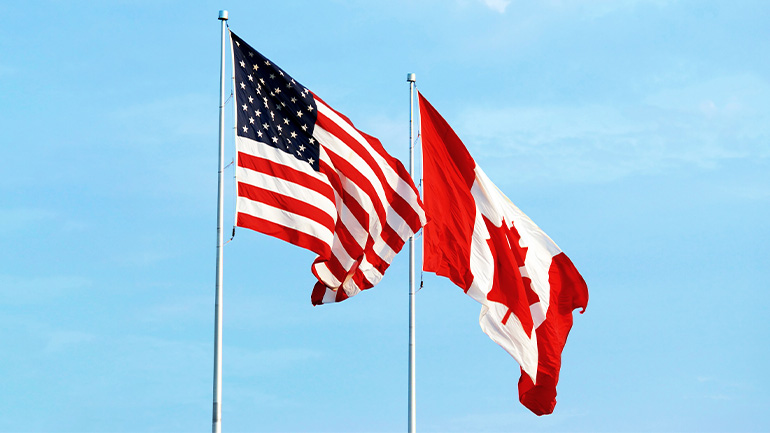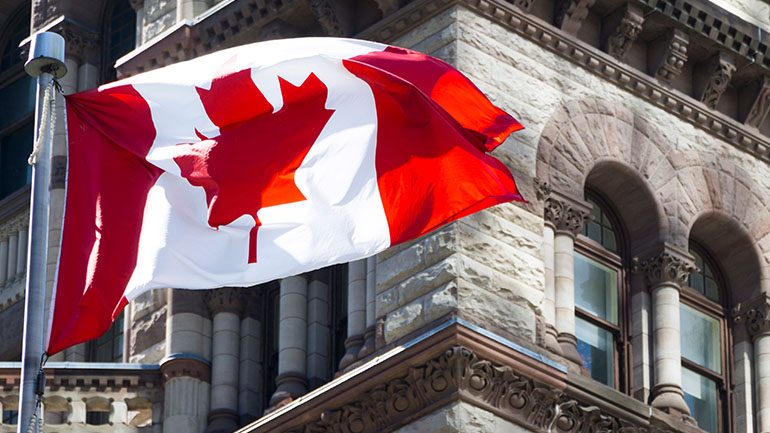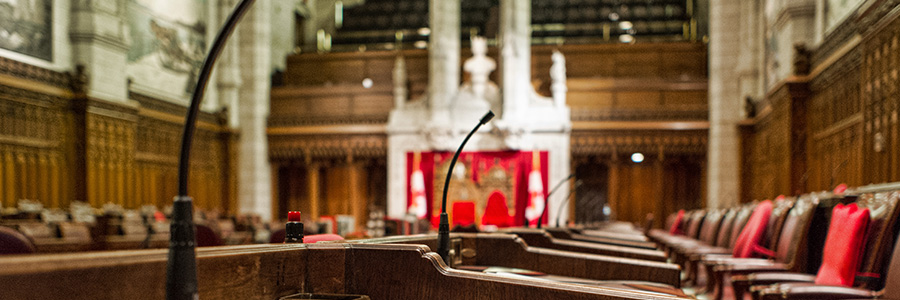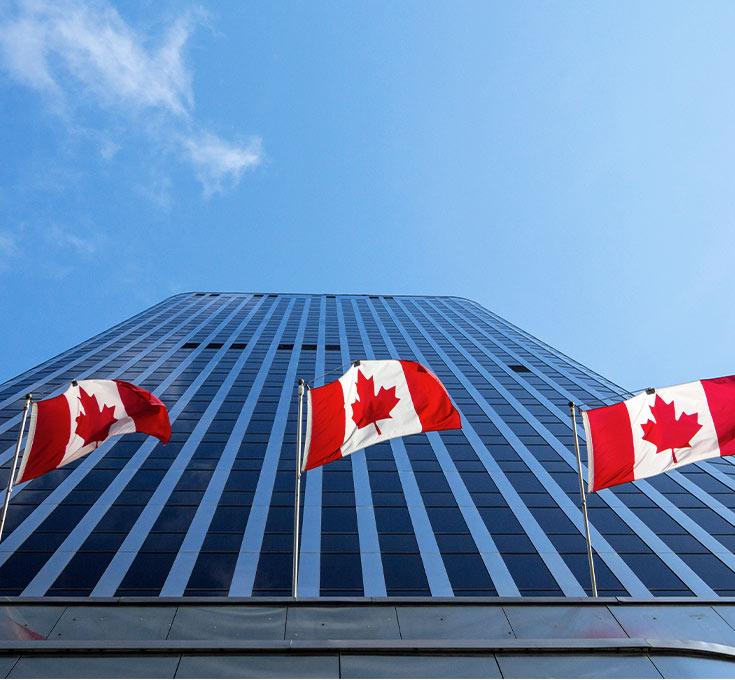U.S. Election Impacts on Canadian Trade
By: Robert Both, Andrew Kelvin
Oct. 17, 2024 - 6 minutes 30 seconds
Overview:
- A Harris victory would likely retain the current administration's international trade policy.
- If Trump wins, Canada could be subject to a 10% tariff on all international imports with reciprocal measures on U.S. imports.
- Participation in the USMCA might exempt Canada from the tariffs with minor concessions.
- The Bank of Canada could respond to a trade war by extending the current easing cycle.
The 2024 U.S. presidential election continues to draw closer ahead of November 5, bringing with it a renewed focus on international trade policy. Even though the race remains too close to call, our starting assumption is that a Harris administration represents a continuation of the status quo for international trade policy, while a return to another Trump administration would bring the threat of increased protectionism and more uncertainty for the U.S. and its trading partners.
Canada was subject to increased trade uncertainty through President Trump's first term in office, where efforts to renegotiate North American Free Trade Agreement (NAFTA) into United States–Mexico–Canada Agreement (USMCA) were overshadowed by threats to invoke Article 2205 and withdraw the U.S. from NAFTA entirely. Canada was also hit by steel (25%) and aluminum (10%) tariffs for nearly 12 months before negotiating an exemption in May 2019, while tariffs on Canadian solar products remained in place from February 2018 until they were ruled a violation of USMCA through the dispute settlement process in February 2022.
The potential tariff threat is much larger in 2025, with former President Trump proposing a 10% tariff on all U.S. imports from countries outside China, while China would face a 60% tariff on all exports to the U.S.
Canadian Economic Policy Uncertainty Through U.S. Election Cycles
Serious Threat?
We believe that President Trump's proposed tariffs should be taken seriously, even if Canada's inclusion in USMCA leaves scope for an exclusion against any broad tariffs. The USMCA dispute resolution panels have already ruled against the U.S. on solar panel tariffs, and the side agreements to USMCA would also help to secure a 60-day exemption to any tariffs imposed.
Those factors could help a successful challenge to new U.S. tariffs, but the timeline for dispute resolution means that any U.S. measures (and retaliation) could remain in place for an extended period if initial talks to secure carve outs are not successful. It does bear mentioning that the Trump administration was the architect of USMCA even if that does not guarantee a frictionless relationship going forward.
Base Case: Canada/Mexico are Exempt from Any New Tariffs
If re-elected, former President Trump's pledge to impose new tariffs in his first 100 days in office leaves little time to negotiate a deal, but our base case is that Canada would see a temporary exemption to buy time for more detailed trade talks following the steel and aluminum playbook from 2018. Canadian media have reported on preliminary discussions to avoid U.S. tariffs under another Trump administration, and those discussions would take on much greater importance during the transition period in a potential Trump victory.
In this scenario, we expect Canada would be able to secure a permanent exemption to U.S. import tariffs with only minor concessions. These could include enhanced monitoring, periodic reviews of Canada-U.S. trade flows or new antidumping requirements in Canada with the implicit threat that tariffs could be reimposed on a surge of Canadian exports into the U.S. The cost from any concessions would be mild, although we would still see a modest terms-of-trade shock if a broader trade war contributes to softer global demand and lower commodity prices.
Alternate Scenario: Canada Hit with 10% Tariffs and Implements Reciprocal Countermeasures
There are no guarantees that Canada's role in USMCA will be enough for an exemption to new U.S. tariffs. If Canada does not receive a permanent exemption to new tariffs, we would expect the federal government to retaliate with reciprocal measures on U.S. imports, although the sheer scope of Canadian imports from the U.S. presents a major challenge.
In this scenario, U.S. tariffs would hit US$419 billion of Canadian exports (or US$300 billion if energy products are excluded), while Canadian countermeasures would need to target virtually all U.S. exports destined for Canada (CA$485 billion in 2023). With merchandise imports accounting for a much larger share of nominal GDP in Canada than in the U.S., import tariffs will be far more impactful on this side of the border and pragmatism may limit any tit-for-tat approach.
Mapping Out the Economic Impact
Our base case for Canada to receive an exemption from any new tariffs in another Trump administration would still introduce a headwind to the domestic growth outlook, reflecting the drag on global demand from a new trade war between the U.S. and non-USMCA trading partners. This scenario would see new tariffs applied to US$2.2 trillion of U.S. imports (8% of nominal GDP), which is magnitudes larger than the 2018-19 U.S.-China trade war where targeted imports accounted for just 0.4% of U.S. GDP. However, that 2018-19 skirmish still had a material impact on U.S.-China trade flows. The headwinds to Canadian growth from new tariffs will be proportional to their impact on the global economy.
If Canada does not secure an exemption to new U.S. tariffs, the domestic impacts will be far larger. In this scenario, Canadian exports would be weighed down by reduced purchasing power from U.S. importers alongside an even larger hit to global demand from new tariffs. Retaliatory countermeasures would introduce a material upside risk to consumer prices in 2025 and beyond.
Tariff revenues could help soften the blow for Canadian consumers if they are put towards personal income tax breaks or direct transfers to households, although this would need to be balanced against supports for the industrial sector. This scenario would also introduce more uncertainty around the longevity of the USMCA pact and prospects to renew the agreement for another 16 years in 2026. However, we could even see some frictions in the renewal process under a Harris administration, given Vice President Harris was one of ten Senators to vote against USMCA ratification in January 2020.
First Order Responses Support Easing, But Second Order Impacts are Clear as Mud
The implications for financial conditions in Canada will be heavily contingent on both the magnitude of trade disruptions and the Canadian government's response. Our instinct is that the Bank of Canada's (BoC) initial response to an escalating trade war would be to accelerate and/or extend the current easing cycle; trade wars are stagflationary, but tariff impacts theoretically fall out of the inflation calculations after 12 months while the decrease in aggregate demand can linger longer.
The complicating factor surrounds the impact of tit-for-tat tariffs on domestic fiscal policy; in an environment where unfriendly U.S. trade policy threatens material economic harm, it is entirely plausible that the Canadian federal and provincial governments respond with expansionary fiscal policy with risk of overcompensation. This would presumably blunt the BoC's initial impulse to respond with easier monetary policy and could conceivably produce an outcome in which inflation and nominal interest rates both prove sticky. All of which is to say, the longer-term risk profile around the front of the curve isn't as obviously skewed downwards as it might appear at first glance.
Moving further out the curve, ongoing large U.S. deficits should push U.S. term premia wider, which will in turn feed into Canadian fixed income. We still see monetary policy as the key driver of curve shape in Canada, but wider global term premia will contribute as well. Moreover, an environment where the government engages in another fiscal expansion would pressure the long end of the curve given that the BoC presumably wouldn't be able to soak up the added supply via quantitative easing. We therefore see a trade war scenario skewed towards steepening out the Canadian curve.
Subscribing clients can read the full report, A Worthwhile Canadian Initiative: Local Implications of the US Election, via the TD One Portal








